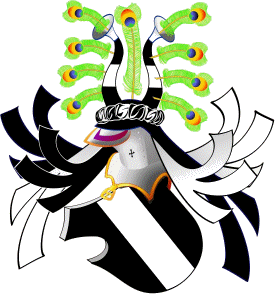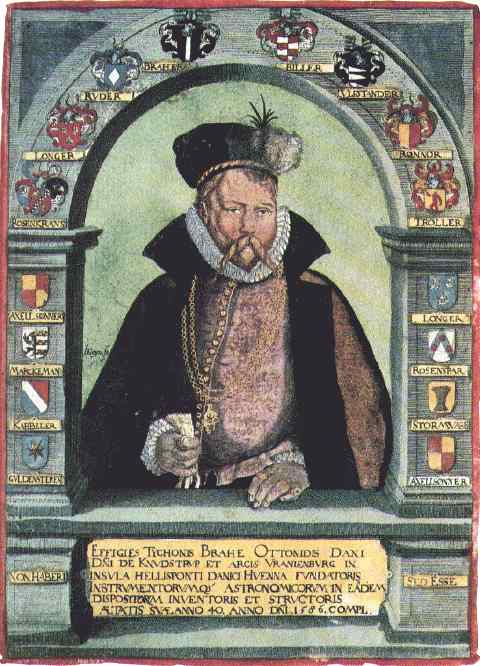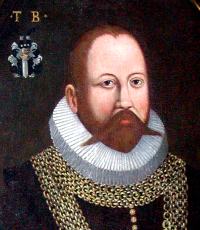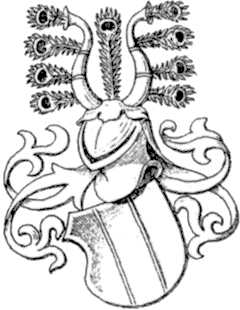

Tycho Brahe (1546-1601)
Danish Astronomer
[ The above is a
copyrighted picture
reproduced here by permission: © 2006
Jochen Wilke. ]
Sable, a pale Argent.
Crest:
A peacock feather between two horns Sable a fess Argent,
each bearing four peacock feathers [fesswise].
Tycho Brahe's precise naked-eye observations of the
motion of the planets paved the way for the accurate mathematical descriptions given by
his famous assistant, Johannes Kepler
(in the form of three laws that would later be completely explained by
Newtonian physics).
In 1578, Tycho Brahe was awarded the very prestigious
Order of the Elephant
for services rendered to the Danish Crown.
The second scientist to be so honored would be
Niels Bohr, in 1947.
Early in November 1572, Tycho Brahe was one of many individuals who independently
observed a spectacular new star
(actually, a Type Ia supernova explosion)
in the Cassiopeia constellation. At first,
the nova outshone Venus
and it would remain visible to the naked eye for more than a year.
Tycho was able to show that the phenomenon lacked any measurable observational parallax,
which proved that it was located well beyond the confines of
the Solar system.
The detailed account Tycho gave in
De nova et nullius aevi memoria prius visa stella (1573)
thus established that the "sphere of fixed stars"
was definitely not as immutable as previously thought.
Tycho's Nova was one of about 8 supernovae visible to the naked eye in recorded
history. Its remnant
(SN 1572, or 3C 10) is now mostly a radio source.

In this famous portrait, Tycho Brahe is surrounded by the arms of his
noble ancestors,
with his own paternal arms at the top, left of center.
Clockwise from bottom right, the
names read:
Gyldenstern (Gyldenstierne),
Kahbiller (Kabel),
Markeman (Markmand),
Axellsønner,
Rosenkrans (Rosenkrantz),
Longer (Lunge),
Ruder (Rud),
Braher (Brahe),
Biller (Bille),
Ulfstander (Ulfstand),
Ronnor (Rønnow),
Troller (Trolle),
Longer (Lunge),
Rosenspar,
Storawase, and
Axellsønner.

Tycho
Brahe (1546-1601) |
|
| |
Rosenkrantz |
![Rosencrans,
Rosenkrantz (Rosencrantz)
[Ancient Arms]](rosenkrantz.gif) |
|
 |
| Gyldenstierne |
The two names of Rosenkrans
and Gyldenstern stand out because of the pair of Shakespearean characters
(Rosencrantz & Guildenstern) in the Tragedy of
Hamlet, prince
of Denmark, which William Shakespeare (1564-1616)
wrote around 1601 (the year Brahe died).
The relevant
ancestors
of Tycho Brahe
(ahnentafels #22 and #23) are
Erik Rosenkrantz (1427-1503) and
Sophie Gyldenstierne (+1477),
parents of Kirstine Rosenkrantz (+1509),
the maternal grandmother of Tycho Brahe's mother, Beate Bille (1526-1605).
It seems most likely that the two famous Shakespearean characters were modeled
after an inseparable pair of vocal students from the
University of Wittenberg
(founded 1502),
Knud Gyldenstierne and Frederick Rosenkrantz,
who visited England and Scotland in 1592, as part of the Danish legation.
Both, like Tycho Brahe himself,
were from the close-knit Danish nobility. Not surprisingly,
the three men were relatives. Frederick Rosenkrantz is presented as
a third cousin of Tycho Brahe's.
Incidentally, Rosenkrantz returned to London in
1600 just as Hamlet was being written
(he had just visted Tycho Brahe in Prague,
traveling with Johannes Kepler).
This piece of trivia keeps popping up on the Internet, with various
speculations next to elements of the above explanation:
- 1996: Klaus Ole Kristiansen.
- 1997:
Peter D. Usher (press release).
1999 follow-up.
- 2001:
David P. Stern (quoting Ferguson about the 1592 historical pair).
- 2003: New Shakespeare Fellowship. Bassanio (quoting Jim Swank).
- Etc.
|
Weirdly, references to the page you're now reading appeared almost simultaneously (October 1, 2006)
in 3 different discussions of this issue.
Within 3 days, we had acknowledged all of those, here.
A funny thermal equilibrium
about reciprocal credits was even quickly reached
with the thread
started by Baez
(without private contacts).

- 2006: Zeborah Fitchett,
Tim Silverman, Brian M. Scott (quoting this page).
- 2006:
John Baez (picture link,
quote of Eric Altschuler), Tim Silverman.
- 2006:
Banubula (a former study partner of Eric Altschuler at Harvard).

The above portrait was engraved in copper in Amsterdam in 1586,
and was used extensively by Tycho Brahe in his own publicity...
In 1590, Tycho sent 4 copies of it (along with 2 copies of his 1588 book)
to a prominent member of Merton College, namely:
Thomas Savile (d. 1593) brother of the warden of the College,
Sir
Henry Savile (1549-1622).

Tycho Brahe was apparently
craving for English epigrams
and he suggested that some excellent English poets might
compose them to praise him and his work...
Tycho Brahe asked Savile to be remembered to the mathematician
John Dee
(1527-1609) and also to Dee's pupil
Thomas
Digges (1546-1595).
Back in 1938, the renowned Shakespeare researcher Leslie Hotson
argued that Shakespeare obtained much of his knowledge of Science
from Thomas Digges and might have learned of Tycho Brahe (and the above portrait)
through Digges.
The Death of Tycho
A dubious legend has it that Tycho died from a burst bladder after a banquet where
he refrained from leaving the table to relieve himself, which would have been
a breach of etiquette. Actually,
Tycho fell ill at that banquet
(on October 13, 1601) and found himself in a medical condition
which made it painful and difficult for him to urinate. He died
10 days later.
In the 1990s, a forensic analysis of hair from Tycho's beard was carried out
and left no doubt that he died from mercury poisoning.
One dose was delivered at the time of the infamous banquet and Tycho ingested another large
dose the day before he died
(the accompanying high level of calcium being consistent with ingestion in milk).
Wild speculations, most notably by
Joshua
and Ann-Lee Gilder,
have blamed Kepler for the murder
(I, for one, find that very hard to believe).
More
recently, evidence has surfaced that the murderer may have been a cousin of Tycho's
who was visiting at the time, Count Eric Brahe, acting on behalf of
King Christian IV
of Denmark (1577-1648).
Professor Peter Andersen, a specialist of Danish renaissance who discovered a lost diary
of Eric Brahe in 2008, estimates that the details recorded by Eric Brahe
amount to an indirect confession...
At the time of his death, Tycho was exiled in Prague because the Danish king
had turned against him for reasons that were unclear to historians until recently.
However, it seems that rumors were circulating that Tycho Brahe had a liaison with
Queen Sophie,
the mother of Christian IV.
Tycho may even have been the king's biological father...












